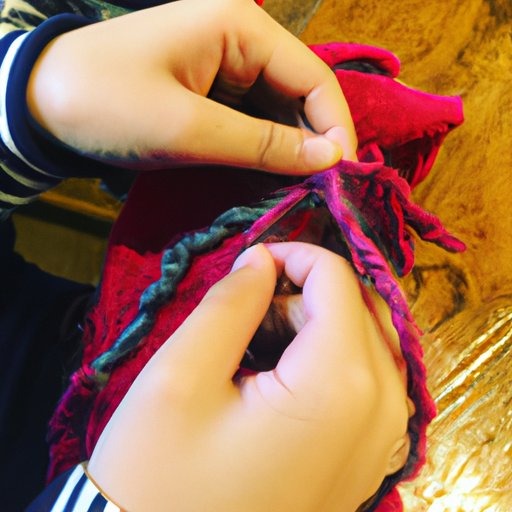
I. Introduction
Hand sewing is a traditional craft that has been passed down through generations. It allows individuals to personalize and create unique items with their bare hands. Whether you are a beginner or experienced crafter, hand sewing can be a rewarding experience. In this article, we will explore the essential tools, different types of stitches, and tips for threading a needle and tying a knot.
II. The Essentials of Hand Sewing: A Beginner’s Guide
Hand sewing is a sewing technique that requires a needle, thread and fabric. It is an essential skill for anyone who enjoys crafting and creating homemade items.
Essential tools for hand sewing include needles, pins, scissors, a seam ripper, thimbles, and measuring tape. Needles come in different sizes and are chosen based on the fabric being used. Pins are used to hold fabric in place while sewing. Scissors should be sharp and used only for cutting fabric. The seam ripper is used to remove stitches if needed. Thimbles can be used to protect fingers from needle pricks. Measuring tape is used to measure fabric and ensure correct sizing.
Different types of stitches include running stitch, backstitch, whip stitch, and blanket stitch. The running stitch is the easiest and most basic stitch, which is used to join two pieces of fabric together. Backstitch is used to create a strong and sturdy seam. Whip stitch is used to sew edges together neatly. Blanket stitch is used to finish the edge of the fabric and can also be used as an embroidery stitch.
To thread a needle, cut the thread to the desired length and run one end through the eye of the needle. To tie a knot, loop the thread around your finger, roll it off your finger and pull the end to create a knot.
III. DIY Sewing: Learn How to Hand Sew for Your Next Crafting Project
Drawing from our own experience, DIY sewing projects can be incredibly fun, fulfilling and cost-effective. Hand sewing is perfect for crafting small projects such as cushions, dolls, decorations, and clothes. It also allows for easy on-the-go projects that require only a needle, thread and fabric.
Some basic DIY sewing projects that can be done by hand include a fabric bookmark, a simple tote bag, or a felt bracelet. The possibilities are endless, and hand sewing allows unlimited creativity.
IV. Stitch by Stitch: Perfecting Your Hand Sewing Techniques
Improving hand sewing skills requires time and challenges. Consistency and uniformity of stitches is important for achieving a professional look. When sewing, the needle should be inserted straight, and the fabric tension should be loose but not too loose.
The most common hand sewing mistakes are knotting the thread improperly, using the wrong stitch, and positioning the needle wrongly. To fix these mistakes, practice and patience are key. With experience, you’ll learn how to identify and fix mistakes quickly.
V. Sewing by Hand: A Traditional Art Revisited
Hand sewing is a traditional art with centuries of history. Different cultures and countries have their sewing traditions that span over time. It is remarkable how hand sewing techniques survived the impact of machine sewing technology. In some cultures, hand sewing is a way of preserving traditions. Notably, quilting, a form of hand-sewing, is a cultural identity and traditional practice in American folk art.
Hand sewing creates unique pieces of art. It can be used to customize clothes or add personal touches to gifts.
VI. The Joy of Hand Sewing: How it Can Improve Your Mindfulness and Creativity
The art of hand sewing comes with a remarkable benefit of mindfulness and creativity that resonates deeply with the human mind. The activity requires focus and hands-on work. It is a gratifying way of calming a racing mind and relaxing the body. Moreover, it allows individuals to tap into their creativity and artistic side, making it an excellent self-care activity.
VII. Slow Sewing: Why Hand Sewing is Worth the Time and Effort
Hand sewing can be a meditative activity that helps individuals slow down, concentrate and enjoy the present moment. It requires patience and attention to detail, which can help individuals develop naturally.
Slow sewing can be part of a mindful lifestyle by encouraging individuals to take breaks from technology and busy lives by losing themselves in creativity.
VIII. Conclusion
Hand sewing has many advantages that make it a unique and satisfying craft. It is a timeless skill that allows individuals to create customized and unique items with their bare hands. It requires essential tools, understanding of hand stitches, and patience, but the rewards are endless. Hand sewing is a relaxing activity that encourages individuals to explore their creativity while fostering their well-being.




